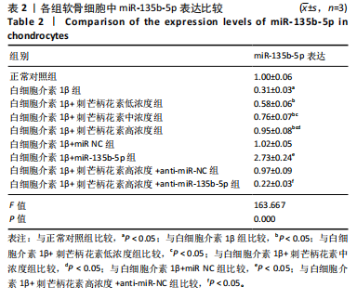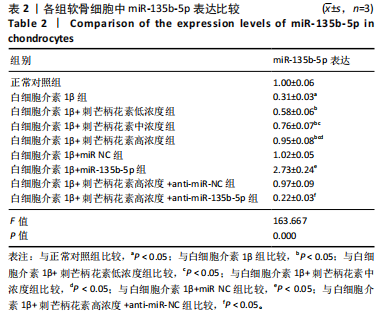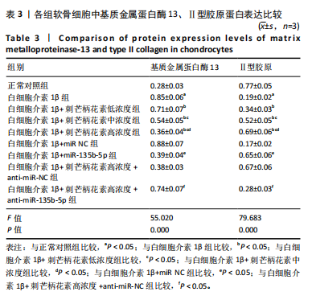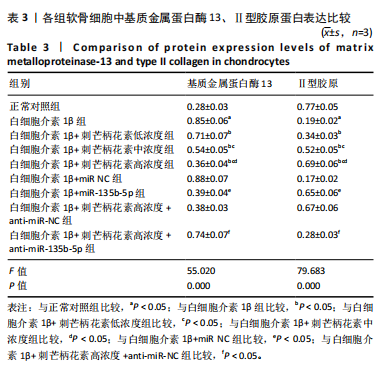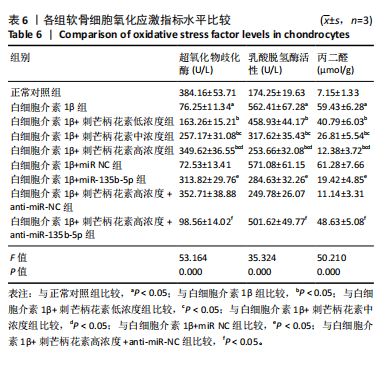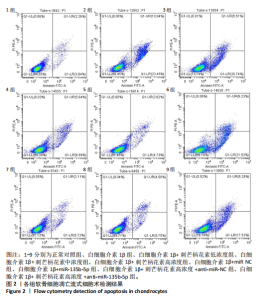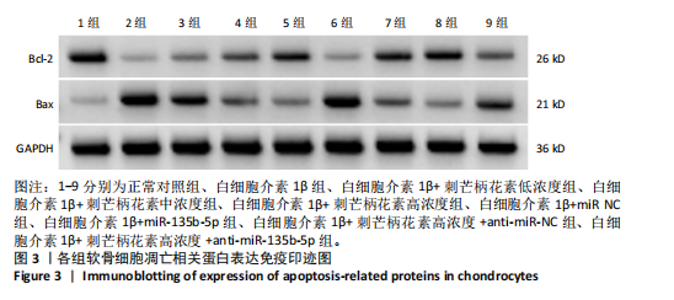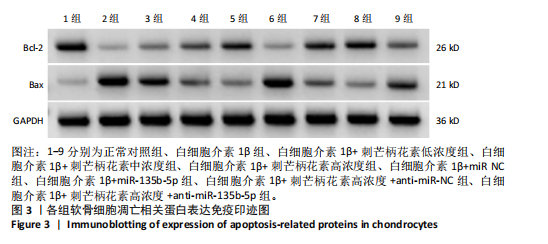Chinese Journal of Tissue Engineering Research ›› 2025, Vol. 29 ›› Issue (12): 2484-2491.doi: 10.12307/2025.388
Previous Articles Next Articles
Mechanism underlying the effect of formononetin on interleukin-1beta-induced chondrocyte injury #br#
#br#
Shan Jixin, Ye Ruibin, Ju Shaohua, Wang Qiang
- Department of Bonesetting, Affiliated Sport Hospital of Chengdu Sport University, Chengdou 610041, Sichuan Province, China
-
Received:2024-03-22Accepted:2024-06-28Online:2025-04-28Published:2024-09-10 -
Contact:Ye Ruibin, Chief physician, Department of Bonesetting, Affiliated Sport Hospital of Chengdu Sport University, Chengdou 610041, Sichuan Province, China -
About author:Shan Jixin, Master, Attending physician, Department of Bonesetting, Affiliated Sport Hospital of Chengdu Sport University, Chengdou 610041, Sichuan Province, China -
Supported by:Sichuan Provincial Administration of Traditional Chinese Medicine Scientific and Technological Research Special Project, No. 2023MS271 (to WQ); Sichuan Provincial Natural Science Foundation, No. 2023NSFC1803 (to JSH)
CLC Number:
Cite this article
Shan Jixin, Ye Ruibin, Ju Shaohua, Wang Qiang. Mechanism underlying the effect of formononetin on interleukin-1beta-induced chondrocyte injury #br#
share this article
Add to citation manager EndNote|Reference Manager|ProCite|BibTeX|RefWorks
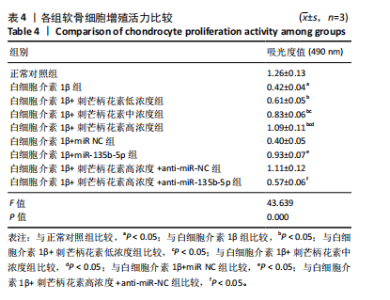
各组软骨细胞基质金属蛋白酶13、Ⅱ型胶原蛋白表达免疫印迹图,见图1。定量分析结果显示,与正常对照组比较,白细胞介素1β组基质金属蛋白酶13蛋白表达升高(P < 0.05),Ⅱ型胶原蛋白表达降低(P < 0.05)。与白细胞介素1β组比较,白细胞介素1β+刺芒柄花素低浓度组、白细胞介素1β+刺芒柄花素中浓度组、白细胞介素1β+刺芒柄花素高浓度组基质金属蛋白酶13蛋白表达降低(P < 0.05),Ⅱ型胶原蛋白表达升高(P < 0.05),并且随着刺芒柄花素浓度的增加,作用更加明显。与白细胞介素1β+miR NC组比较,白细胞介素1β+miR-135b-5p组基质金属蛋白酶13蛋白表达降低(P < 0.05),Ⅱ型胶原蛋白表达升高(P < 0.05);与白细胞介素1β+刺芒柄花素高浓度+anti-miR-NC组比较,白细胞介素1β+刺芒柄花素高浓度+anti-miR-135b-5p组基质金属蛋白酶13蛋白表达升高(P < 0.05),Ⅱ型胶原蛋白表达降低(P < 0.05)。 2.4 各组软骨细胞增殖活力比较 见表4。"
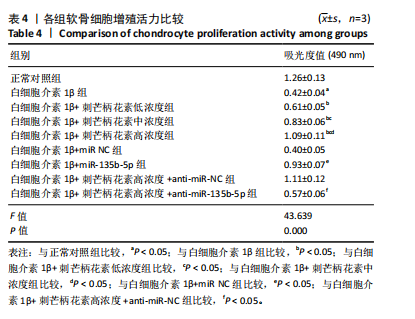
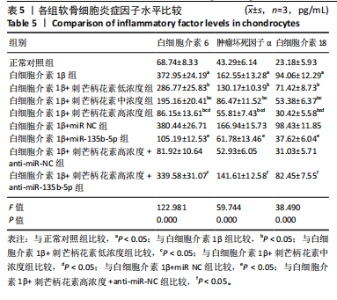
MTT检测结果显示,白细胞介素1β组细胞增殖吸光度值低于正常对照组(P < 0.05),白细胞介素1β+刺芒柄花素低浓度组、白细胞介素1β+刺芒柄花素中浓度组、白细胞介素1β+刺芒柄花素高浓度组细胞增殖吸光度值高于白细胞介素1β组(P < 0.05),并且随着刺芒柄花素浓度的增加,细胞增殖吸光度值升高;白细胞介素1β+miR-135b-5p组细胞增殖吸光度值高于白细胞介素1β+miR NC组(P < 0.05),白细胞介素1β+刺芒柄花素高浓度+anti-miR-135b-5p组细胞增殖吸光度值低于白细胞介素1β+刺芒柄花素高浓度+anti-miR-NC组(P < 0.05)。 2.5 各组软骨细胞炎症因子水平比较 见表5。 与正常对照组比较,白细胞介素1β组肿瘤坏死因子α、白细胞介素6、白细胞介素18水平均升高(P < 0.05)。与白细胞介素1β组比较,白细胞介素1β+刺芒柄花素低浓度组、白细胞介素1β+刺芒柄花素中浓度组、白细胞介素1β+刺芒柄花素高浓度组肿瘤坏死因子α、白细胞介素6、白细胞介素18水平均降低(P < 0.05),并且随着刺芒柄花素浓度的增加,降低作用更明显。与白细胞介素1β+miR NC组比较,白细胞介素1β+miR-135b-5p组肿瘤坏死因子α、白细胞介素6、白细胞介素18水平均降低"
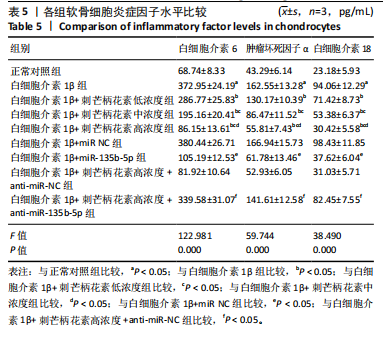
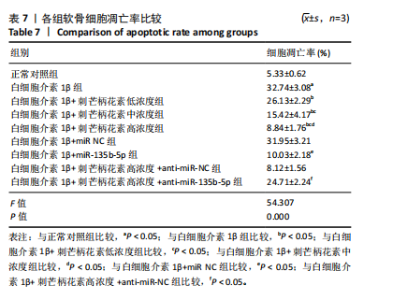
与正常对照组比较,白细胞介素1β组超氧化物歧化酶活性降低(P < 0.05),乳酸脱氢酶活性、丙二醛水平升高(P < 0.05)。与白细胞介素1β组,白细胞介素1β+刺芒柄花素低浓度组、白细胞介素1β+刺芒柄花素中浓度组、白细胞介素1β+刺芒柄花素高浓度组超氧化物歧化酶活性升高(P < 0.05),乳酸脱氢酶活性、丙二醛水平降低(P < 0.05),并且随着刺芒柄花素浓度的增加,作用更加明显。与白细胞介素1β+miR NC组比较,白细胞介素1β+miR-135b-5p组超氧化物歧化酶活性升高(P < 0.05),乳酸脱氢酶活性、丙二醛水平降低(P < 0.05)。与白细胞介素1β+刺芒柄花素高浓度+anti-miR-NC组比较,白细胞介素1β+刺芒柄花素高浓度+anti-miR-135b-5p组超氧化物歧化酶活性降低(P < 0.05),乳酸脱氢酶活性、丙二醛水平升高(P < 0.05)。 2.7 各组软骨细胞凋亡率比较 见表7。"
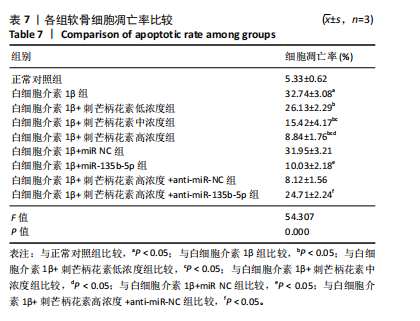
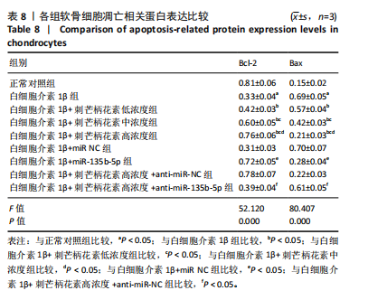
各组软骨细胞凋亡流式细胞术检测结果,见图2。定量分析结果显示,白细胞介素1β组细胞凋亡率高于正常对照组(P < 0.05);白细胞介素1β+刺芒柄花素低浓度组、白细胞介素1β+刺芒柄花素中浓度组、白细胞介素1β+刺芒柄花素高浓度组细胞凋亡率低于白细胞介素1β组(P < 0.05),并且随着刺芒柄花素浓度的增加,细胞凋亡率降低;白细胞介素1β+miR-135b-5p组细胞凋亡率低于白细胞介素1β+miR NC组(P < 0.05),白细胞介素1β+刺芒柄花素高浓度+anti-miR-135b-5p组细胞凋亡率高于白细胞介素1β+刺芒柄花素高浓度+anti-miR-NC组(P < 0.05)。 2.8 各组软骨细胞Bcl-2、Bax蛋白表达比较 见表8。"
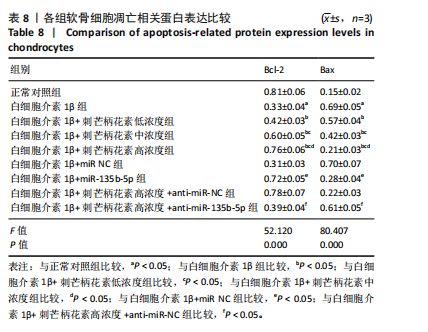
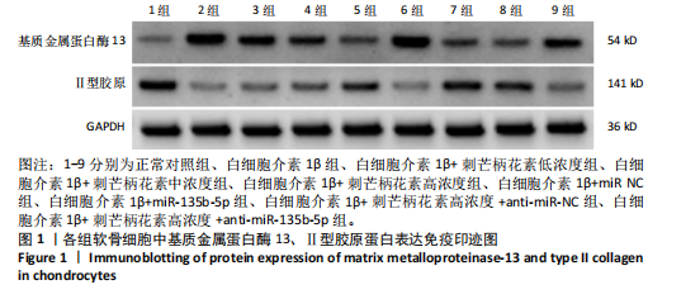
各组软骨细胞Bcl-2、Bax蛋白表达免疫印迹图,见图3。定量分析结果显示,与正常对照组比较,白细胞介素1β组Bcl-2蛋白表达降低(P < 0.05),Bax蛋白表达升高(P < 0.05);与白细胞介素1β组比较,白细胞介素1β+刺芒柄花素低浓度组、白细胞介素1β+刺芒柄花素中浓度组、白细胞介素1β+刺芒柄花素高浓度组Bcl-2蛋白表达升高(P < 0.05),Bax蛋白表达降低(P < 0.05),并且随着刺芒柄花素浓度的增加,作用更加明显;与白细胞介素1β+miR NC组比较,白细胞介素1β+miR-135b-5p组Bcl-2蛋白表达升高(P < 0.05),Bax蛋白表达降低(P < 0.05);与白细胞介素1β+刺芒柄花素高浓度+anti-miR-NC组比较,白细胞介素1β+刺芒柄花素高浓度+anti-miR-135b-5p组Bcl-2蛋白表达降低(P < 0.05),Bax蛋白表达升高(P < 0.05)。"
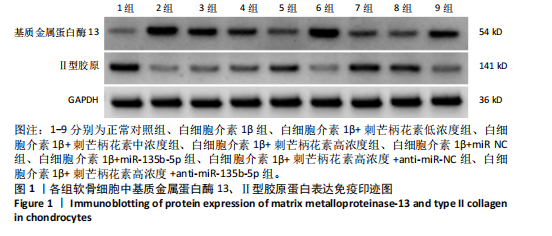
| [1] LIU C, WANG B, XIAO L, et al. Protective effects of the pericellular matrix of chondrocyte on articular cartilage against the development of osteoarthritis. Histol Histopathol. 2018;33(8):757-764. [2] 汪博,张明焕.CIRC_0044235靶向miR-574-5p减轻IL-1β诱导的人软骨细胞损伤[J].基础医学与临床,2023,43(3):419-426. [3] JENEI-LANZL Z, MEURER A, ZAUCKE F. Interleukin-1β signaling in osteoarthritis - chondrocytes in focus. Cell Signal. 2019;53(1):212-223. [4] CHANG Q, LI C, HU J, et al. Protective effects of hsa_circ_0072568 on interleukin‑1β‑stimulated human chondrocytes are mediated via the miR-382-5p/TOP1 axis. Exp Ther Med. 2023;26(2):383-391. [5] 周海银,罗兰,陈艳瑛,等.刺芒柄花素通过调控SIRT1/PGC-1α通路对脓毒症诱导的大鼠急性肾损伤的影响[J].中医药导报,2022, 28(1):6-11. [6] 张春华,胡凌云,解云,等.刺芒柄花素通过阻断海马组织NF-κB通路抑制炎症因子释放改善慢性轻度不可预见性应激老龄大鼠认知行为[J].细胞与分子免疫学杂志,2023,39(7):610-616. [7] SHAH R, YERI A, DAS A, et al. Small RNA-seq during acute maximal exercise reveal RNAs involved in vascular inflammation and cardiometabolic health: brief report. Am J Physiol Heart Circ Physiol. 2017;313(6):H1162-H1167. [8] 李坤,张育民,王亚康,等.上调microRNA-543表达对大鼠骨关节炎软骨细胞的保护作用[J].中国临床医学,2018,25(2):239-243. [9] XU J, QIAN X, DING R. MiR-24-3p attenuates IL-1β-induced chondrocyte injury associated with osteoarthritis by targeting BCL2L12. J Orthop Surg Res. 2021;16(1):371-380. 10] DUAN Q, SUN W, YUAN H, et al. MicroRNA-135b-5p prevents oxygen-glucose deprivation and reoxygenation-induced neuronal injury through regulation of the GSK-3β/Nrf2/ARE signaling pathway. Arch Med Sci. 2018;14(4):735-744. [11] 赵晓东,王磊.miR-135b-5p对IL-1β诱导软骨细胞损伤的影响及机制研究[J].河北医药,2021,43(8):1136-1141. [12] 林燕云,游纯秋,蒋擎,等.独活寄生汤抑制白细胞介素-1β诱导的软骨细胞凋亡的作用机制[J].中国老年学杂志,2019,39(7):1702-1705. [13] 高莉晶,李婷,原丽,等.刺芒柄花素对高糖诱导的H902心肌细胞损伤的作用机制[J].中国临床药理学杂志,2022,38(23):2820-2824. [14] 徐翀,申利民,苑文杰.当归多糖通过Wnt/β-catenin信号通路抑制骨关节炎软骨细胞氧化应激损伤与炎症反应[J].陕西中医,2022, 43(6):700-703,770. [15] 李伟,黄耀凯,王洪林,等.槲皮素通过下调MALAT1抑制膝骨关节炎小鼠软骨损伤及软骨细胞凋亡的相关机制[J].中华骨质疏松和骨矿盐疾病杂志,2023,16(1):33-40. [16] ALADAILEH SH, HUSSEIN OE, ABUKHALIL MH, et al. Formononetin Upregulates Nrf2/HO-1 Signaling and Prevents Oxidative Stress, Inflammation, and Kidney Injury in Methotrexate-Induced Rats. Antioxidants (Basel). 2019;8(10):430. [17] 郝炎,李治成,陈越,等.刺芒柄花素对顺铂所致大鼠急性肾损伤的保护作用及其机制[J].川北医学院学报,2022,37(3):279-284. [18] 胡志平,马俊,陈彦蓉,等.刺芒柄花素激活脑外伤小鼠Nrf2/HO-1通路减轻脑水肿并改善行为障碍[J]. 中国实验诊断学,2021, 25(6):887-893. [19] YU L, ZHANG Y, CHEN Q, et al. Formononetin protects against inflammation associated with cerebral ischemia-reperfusion injury in rats by targeting the JAK2/STAT3 signaling pathway. Biomed Pharmacother. 2022;149(1):1-9. [20] JIANG Y. Osteoarthritis year in review 2021: biology. Osteoarthritis Cartilage. 2022;30(2):207-215. [21] LIANG L, ZHANG F, FENG N, et al. IRE1α protects against osteoarthritis by regulating progranulin-dependent XBP1 splicing and collagen homeostasis. Exp Mol Med. 2023;55(11):2376-2389. [22] PAN D, YIN P, LI L, et al. Holomycin, a novel NLRP3 inhibitor, attenuates cartilage degeneration and inflammation in osteoarthritis. Biochem Biophys Res Commun. 2023;657(21):59-68. [23] Li Y, Tang L, Duan Y, et al. Upregulation of MMP-13 and TIMP-1 expression in response to mechanical strain in MC3T3-E1 osteoblastic cells. BMC Res Notes. 2010;17(3):309-321. [24] Lan Q, Lu R, Chen H, et al. MMP-13 enzyme and pH responsive theranostic nanoplatform for osteoarthritis. J Nanobiotechnology. 2020;18(1):117-131. [25] MAO J, ZHANG L. MiR-320a upregulation improves IL-1β-induced osteoarthritis via targeting the DAZAP1 and MAPK pathways. J Orthop Surg Res. 2023;18(1):541-253. [26] HORVÁTH E, SÓLYOM Á, SZÉKELY J, et al. Inflammatory and Metabolic Signaling Interfaces of the Hypertrophic and Senescent Chondrocyte Phenotypes Associated with Osteoarthritis. Int J Mol Sci. 2023;24(22):16468-16579. [27] 段大波,张树鹰.血清TGF-β1、TIMP-1、TNF-α及IL-17在膝关节骨性关节炎患者血清变化情况及其与病情严重程度的关系[J].中国实验诊断学,2023,27(7):825-828. [28] 卞雅莉,陈晓宏,季晶俊,等.等速肌力训练联合时空针灸灵龟八法治疗老年肝肾亏虚型膝骨关节炎的疗效及对血清细胞因子的影响[J].现代生物医学进展,2022,22(7):1257-1261. [29] TUDORACHI NB, TOTU EE, FIFERE A, et al. The Implication of Reactive Oxygen Species and Antioxidants in Knee Osteoarthritis. Antioxidants (Basel). 2021;10(6):985-997. [30] LI J, DENG C, LIANG W, et al. Mn-containing bioceramics inhibit osteoclastogenesis and promote osteoporotic bone regeneration via scavenging ROS. Bioact Mater. 2021;6(11):3839-3850. [31] 王翠平,梁翼,余文景,等.消增强骨片联合西药治疗对膝骨关节炎患者疼痛症状、关节功能及氧化应激的影响[J].成都医学院学报,2023,18(6):732-735. [32] 裴珍珍,王革生,东潇博,等.益气通络方含药血清通过减弱氧化应激反应和激活PI3K/AKT信号通路对PC12细胞氧化应激损伤模型的保护作用[J].辽宁中医药大学学报,2023,25(2):36-41. [33] JING L, GAO R, ZHANG J, et al. Norwogonin attenuates hypoxia-induced oxidative stress and apoptosis in PC12 cells. BMC Complement Med Ther. 2021;21(1):18-31. [34] 马天文,于跃,吕良钰,等.白果内酯对IL-1β诱导的ATDC5软骨细胞自噬、增殖和凋亡的影响[J].畜牧兽医学报,2023,54(2):837-846. [35] RAJ SR, D ND, MONDAL S, et al. Expression analysis of pro-apoptotic BAX and anti-apoptotic BCL-2 genes in relation to lactation performance in Deoni and Holstein Friesian crossbred cows. Anim Biotechnol. 2023;34(4):1354-1361. [36] XU K, LIU Z, PAN S, et al. BMSCs attenuate radiation-induced brain injury induced hippocampal neuronal apoptosis through a PI3K/Akt/Bax/Bcl-2 signaling pathway. Brain Res. 2024;15(1):1829-1842. [37] LIU W, RONG Y, WANG J, et al. Exosome-shuttled miR-216a-5p from hypoxic preconditioned mesenchymal stem cells repair traumatic spinal cord injury by shifting microglial M1/M2 polarization. J Neuroinflammation. 2020;17(1):47-68. [38] WANG C, GUO X, WANG Y, et al. Silencing of miR-324-5p alleviates rat spinal cord injury by Sirt1. Neurosci Res. 2021;173(4):34-43. [39] zhao l, qi y, xu l, et al. MicroRNA-140-5p aggravates doxorubicin-induced cardiotoxicity by promoting myocardial oxidative stress via targeting Nrf2 and Sirt2. Redox Biol. 2018;5(1):284-296. [40] LU K, WANG Q, HAO L, et al. miR-204 ameliorates osteoarthritis pain by inhibiting SP1-LRP1 signaling and blocking neuro-cartilage interaction. Bioact Mater. 2023;26(20):425-436. [41] LIU Y, ZHANG Z, LU X, et al. Senescence-responsive miR-33-5p promotes chondrocyte senescence and osteoarthritis progression by targeting SIRT6. Int Immunopharmacol. 2023;121(2):110506-11613. [42] CHENG C, TIAN Y, YANG R, et al. miR-5581 Contributes to Osteoarthritis by Targeting NRF1 to Disturb the Proliferation and Functions of Chondrocytes. Am J Pathol. 2023;193(9):1234-1247. [43] HUANG Y, WANG Y, OUYANG Y. Elevated microRNA-135b-5p relieves neuronal injury and inflammation in post-stroke cognitive impairment by targeting NR3C2. Int J Neurosci. 2022;132(1):58-66. [44] 臧宾宾,李华,杨颖,等. miR-135b-5p抑制脓毒症引起的小鼠急性肺损伤(ALI)的作用及机制[J].中国应用生理学杂志,2022,38(4): 366-372. |
| [1] | Yu Shuai, Liu Jiawei, Zhu Bin, Pan Tan, Li Xinglong, Sun Guangfeng, Yu Haiyang, Ding Ya, Wang Hongliang. Hot issues and application prospects of small molecule drugs in treatment of osteoarthritis [J]. Chinese Journal of Tissue Engineering Research, 2025, 29(9): 1913-1922. |
| [2] | Zhao Jiyu, Wang Shaowei. Forkhead box transcription factor O1 signaling pathway in bone metabolism [J]. Chinese Journal of Tissue Engineering Research, 2025, 29(9): 1923-1930. |
| [3] | Yin Lu, Jiang Chuanfeng, Chen Junjie, Yi Ming, Wang Zihe, Shi Houyin, Wang Guoyou, Shen Huarui. Effect of Complanatoside A on the apoptosis of articular chondrocytes [J]. Chinese Journal of Tissue Engineering Research, 2025, 29(8): 1541-1547. |
| [4] | Li Kaiying, Wei Xiaoge, Song Fei, Yang Nan, Zhao Zhenning, Wang Yan, Mu Jing, Ma Huisheng. Mechanism of Lijin manipulation regulating scar formation in skeletal muscle injury repair in rabbits [J]. Chinese Journal of Tissue Engineering Research, 2025, 29(8): 1600-1608. |
| [5] | Li Jun, Gong Jingjing, Sun Guobin, Guo Rui, Ding Yang, Qiang Lijuan, Zhang Xiaoli, Fang Zhanhai . miR-27a-3p promotes the proliferation of human hypertrophic scar fibroblasts by regulating mitogen-activated protein kinase signaling pathway [J]. Chinese Journal of Tissue Engineering Research, 2025, 29(8): 1609-1617. |
| [6] | Hu Taotao, Liu Bing, Chen Cheng, Yin Zongyin, Kan Daohong, Ni Jie, Ye Lingxiao, Zheng Xiangbing, Yan Min, Zou Yong. Human amniotic mesenchymal stem cells overexpressing neuregulin-1 promote skin wound healing in mice [J]. Chinese Journal of Tissue Engineering Research, 2025, 29(7): 1343-1349. |
| [7] | Jin Kai, Tang Ting, Li Meile, Xie Yuan. Effects of conditioned medium and exosomes of human umbilical cord mesenchymal stem cells on proliferation, migration, invasion, and apoptosis of hepatocellular carcinoma cells [J]. Chinese Journal of Tissue Engineering Research, 2025, 29(7): 1350-1355. |
| [8] | Liu Qi, Li Linzhen, Li Yusheng, Jiao Hongzhuo, Yang Cheng, Zhang Juntao. Icariin-containing serum promotes chondrocyte proliferation and chondrogenic differentiation of stem cells in the co-culture system of three kinds of cells [J]. Chinese Journal of Tissue Engineering Research, 2025, 29(7): 1371-1379. |
| [9] | Chi Wenxin, Zhang Cunxin, Gao Kai, Lyu Chaoliang, Zhang Kefeng. Mechanism by which nobiletin inhibits inflammatory response of BV2 microglia [J]. Chinese Journal of Tissue Engineering Research, 2025, 29(7): 1321-1327. |
| [10] | Yang Zhihang, Sun Zuyan, Huang Wenliang, Wan Yu, Chen Shida, Deng Jiang. Nerve growth factor promotes chondrogenic differentiation and inhibits hypertrophic differentiation of rabbit bone marrow mesenchymal stem cells [J]. Chinese Journal of Tissue Engineering Research, 2025, 29(7): 1336-1342. |
| [11] | He Guanghui, Yuan Jie, Ke Yanqin, Qiu Xiaoting, Zhang Xiaoling. Hemin regulates mitochondrial pathway of oxidative stress in mouse chondrocytes [J]. Chinese Journal of Tissue Engineering Research, 2025, 29(6): 1183-1191. |
| [12] | He Bo, Chen Wen, Ma Suilu, He Zhijun, Song Yuan, Li Jinpeng, Liu Tao, Wei Xiaotao, Wang Weiwei, Xie Jing . Pathogenesis and treatment progress of flap ischemia-reperfusion injury [J]. Chinese Journal of Tissue Engineering Research, 2025, 29(6): 1230-1238. |
| [13] | Wang Yuru, Li Siyuan, Xu Ye, Zhang Yumeng, Liu Yang, Hao Huiqin. Effects of wogonin on joint inflammation in collagen-induced arthritis rats via the endoplasmic reticulum stress pathway [J]. Chinese Journal of Tissue Engineering Research, 2025, 29(5): 1026-1035. |
| [14] | Lan Shuangli, Xiang Feifan, Deng Guanghui, Xiao Yukun, Yang Yunkang, Liang Jie. Naringin inhibits iron deposition and cell apoptosis in bone tissue of osteoporotic rats [J]. Chinese Journal of Tissue Engineering Research, 2025, 29(5): 888-898. |
| [15] | Niu Yongkang, Feng Zhiwei, Wang Yaobin, Liu Zhongcheng, Xiang Dejian, Liang Xiaoyuan, Yi Zhi, Zhan Hongwei, Geng Bin, Xia Yayi. Resveratrol activates extracellular-regulated protein kinase 5 signaling protein to promote proliferation of mouse MC3T3-E1 cells [J]. Chinese Journal of Tissue Engineering Research, 2025, 29(5): 908-916. |
| Viewed | ||||||
|
Full text |
|
|||||
|
Abstract |
|
|||||
